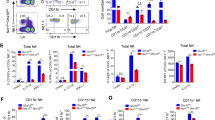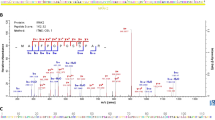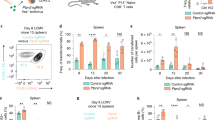Abstract
Class IA phosphotidylinositol-3-kinases (PI3Ks) are a family of p85/p110 heterodimeric lipid kinases that are important in regulating signaling events in B and T cells. However, their role in natural killer (NK) cells is not understood. Here, using mice that lack the regulatory p85α subunit and its alternatively spliced variants p55α/p50α (collectively termed as p85α−/−), we defined the role of PI3K in NK cell development and function. p85α−/− mice had impaired lineage commitment leading to reduced NK cellularity in the bone marrow and liver. p85α−/− NK cells showed a defective Ly49 subset specification and a decreased expression of CD43. Lack of p85α severely reduced the NK-mediated cytotoxicity against tumor cells representing ‘induced-self’ and ‘missing-self’. More importantly, NKG2D and NK1.1 receptor-mediated cytokine and chemokine generation was significantly compromised in p85α−/− NK cells. These results reveal a previously unrecognized role of p85α in the development, terminal maturation, cytokine/chemokine generation and tumor clearance of NK cells.
This is a preview of subscription content, access via your institution
Access options
Subscribe to this journal
Receive 6 digital issues and online access to articles
$119.00 per year
only $19.83 per issue
Buy this article
- Purchase on Springer Link
- Instant access to full article PDF
Prices may be subject to local taxes which are calculated during checkout







Similar content being viewed by others
References
Lanier LL . NK cell recognition. Annu Rev Immunol 2005; 23: 225–274.
Karre K, Schneider G . Immunology. The footprint of a killer. Nature 2000; 405: 527–528.
Chiesa S, Mingueneau M, Fuseri N, Malissen B, Raulet DH, Malissen M et al. Multiplicity and plasticity of natural killer cell signaling pathways. Blood 2006; 107: 2364–2372.
Groh V, Bahram S, Bauer S, Herman A, Beauchamp M, Spies T . Cell stress-regulated human major histocompatibility complex class I gene expressed in gastrointestinal epithelium. Proc Natl Acad Sci USA 1996; 93: 12445–12450.
Cosman D, Mullberg J, Sutherland CL, Chin W, Armitage R, Fanslow W et al. ULBPs, novel MHC class I-related molecules, bind to CMV glycoprotein UL16 and stimulate NK cytotoxicity through the NKG2D receptor. Immunity 2001; 14: 123–133.
Diefenbach A, Jamieson AM, Liu SD, Shastri N, Raulet DH . Ligands for the murine NKG2D receptor: expression by tumor cells and activation of NK cells and macrophages. Nat Immunol 2000; 1: 119–126.
Cerwenka A, Bakker AB, McClanahan T, Wagner J, Wu J, Phillips JH et al. Retinoic acid early inducible genes define a ligand family for the activating NKG2D receptor in mice. Immunity 2000; 12: 721–727.
Carayannopoulos LN, Naidenko OV, Fremont DH, Yokoyama WM . Cutting edge: murine UL16-binding protein-like transcript 1: a newly described transcript encoding a high-affinity ligand for murine NKG2D. J Immunol 2002; 169: 4079–4083.
Wu J, Song Y, Bakker AB, Bauer S, Spies T, Lanier LL et al. An activating immunoreceptor complex formed by NKG2D and DAP10. Science 1999; 285: 730–732.
Wu J, Cherwinski H, Spies T, Phillips JH, Lanier LL . DAP10 and DAP12 form distinct, but functionally cooperative, receptor complexes in natural killer cells. J Exp Med 2000; 192: 1059–1068.
Gilfillan S, Ho EL, Cella M, Yokoyama WM, Colonna M . NKG2D recruits two distinct adapters to trigger NK cell activation and costimulation. Nat Immunol 2002; 3: 1150–1155.
McVicar DW, Taylor LS, Gosselin P, Willette-Brown J, Mikhael AI, Geahlen RL et al. DAP12-mediated signal transduction in natural killer cells. A dominant role for the Syk protein-tyrosine kinase. J Biol Chem 1998; 273: 32934–32942.
Zompi S, Hamerman JA, Ogasawara K, Schweighoffer E, Tybulewicz VL, Di Santo JP et al. NKG2D triggers cytotoxicity in mouse NK cells lacking DAP12 or Syk family kinases. Nat Immunol 2003; 4: 565–572.
Carlyle JR, Martin A, Mehra A, Attisano L, Tsui FW, Zuniga-Pflucker JC . Mouse NKR-P1B, a novel NK1.1 antigen with inhibitory function. J Immunol 1999; 162: 5917–5923.
Iizuka K, Naidenko OV, Plougastel BF, Fremont DH, Yokoyama WM . Genetically linked C-type lectin-related ligands for the NKRP1 family of natural killer cell receptors. Nat Immunol 2003; 4: 801–807.
Arase N, Arase H, Park SY, Ohno H, Ra C, Saito T . Association with FcRgamma is essential for activation signal through NKR-P1 (CD161) in natural killer (NK) cells and NK1.1+ T cells. J Exp Med 1997; 186: 1957–1963.
Held W, Roland J, Raulet DH . Allelic exclusion of Ly49-family genes encoding class I MHC-specific receptors on NK cells. Nature 1995; 376: 355–358.
Raulet DH, Held W, Correa I, Dorfman JR, Wu MF, Corral L . Specificity, tolerance and developmental regulation of natural killer cells defined by expression of class I-specific Ly49 receptors. Immunol Rev 1997; 155: 41–52.
Okkenhaug K, Bilancio A, Farjot G, Priddle H, Sancho S, Peskett E et al. Impaired B and T cell antigen receptor signaling in p110delta PI 3-kinase mutant mice. Science 2002; 297: 1031–1034.
Fruman DA, Snapper SB, Yballe CM, Davidson L, Yu JY, Alt FW et al. Impaired B cell development and proliferation in absence of phosphoinositide 3-kinase p85alpha. Science 1999; 283: 393–397.
Suzuki H, Terauchi Y, Fujiwara M, Aizawa S, Yazaki Y, Kadowaki T et al. Xid-like immunodeficiency in mice with disruption of the p85alpha subunit of phosphoinositide 3-kinase. Science 1999; 283: 390–392.
Vanhaesebroeck B, Leevers SJ, Panayotou G, Waterfield MD . Phosphoinositide 3-kinases: a conserved family of signal transducers. Trends Biochem Sci 1997; 22: 267–272.
Vanhaesebroeck B, Ali K, Bilancio A, Geering B, Foukas LC . Signalling by PI3K isoforms: insights from gene-targeted mice. Trends Biochem Sci 2005; 30: 194–204.
Kane LP, Weiss A . The PI-3 kinase/Akt pathway and T cell activation: pleiotropic pathways downstream of PIP3. Immunol Rev 2003; 192: 7–20.
Kim S, Jee K, Kim D, Koh H, Chung J . Cyclic AMP inhibits Akt activity by blocking the membrane localization of PDK1. J Biol Chem 2001; 276: 12864–12870.
Saito K, Tolias KF, Saci A, Koon HB, Humphries LA, Scharenberg A et al. BTK regulates PtdIns-4,5-P2 synthesis: importance for calcium signaling and PI3K activity. Immunity 2003; 19: 669–678.
Dai X, Chen Y, Schuman J, Hua Z, Adamson JW, Wen R et al. Distinct roles of phosphoinositide-3 kinase and phospholipase Cgamma2 in B-cell receptor-mediated signal transduction. Mol Cell Biol 2006; 26: 88–99.
Regunathan J, Chen Y, Kutlesa S, Dai X, Bai L, Wen R et al. Differential and nonredundant roles of phospholipase Cgamma2 and phospholipase Cgamma1 in the terminal maturation of NK cells. J Immunol 2006; 177: 5365–5376.
Park SY, Saijo K, Takahashi T, Osawa M, Arase H, Hirayama N et al. Developmental defects of lymphoid cells in Jak3 kinase-deficient mice. Immunity 1995; 3: 771–782.
Saijo K, Park SY, Ishida Y, Arase H, Saito T . Crucial role of Jak3 in negative selection of self-reactive T cells. J Exp Med 1997; 185: 351–356.
Kim S, Iizuka K, Kang HS, Dokun A, French AR, Greco S et al. In vivo developmental stages in murine natural killer cell maturation. Nat Immunol 2002; 3: 523–528.
Rosmaraki EE, Douagi I, Roth C, Colucci F, Cumano A, Di Santo JP . Identification of committed NK cell progenitors in adult murine bone marrow. Eur J Immunol 2001; 31: 1900–1909.
Vosshenrich CA, Ranson T, Samson SI, Corcuff E, Colucci F, Rosmaraki EE et al. Roles for common cytokine receptor gamma-chain-dependent cytokines in the generation, differentiation, and maturation of NK cell precursors and peripheral NK cells in vivo. J Immunol 2005; 174: 1213–1221.
Fahlen L, Lendahl U, Sentman CL . MHC class I-Ly49 interactions shape the Ly49 repertoire on murine NK cells. J Immunol 2001; 166: 6585–6592.
Held W, Dorfman JR, Wu MF, Raulet DH . Major histocompatibility complex class I-dependent skewing of the natural killer cell Ly49 receptor repertoire. Eur J Immunol 1996; 26: 2286–2292.
Kim S, Poursine-Laurent J, Truscott SM, Lybarger L, Song YJ, Yang L et al. Licensing of natural killer cells by host major histocompatibility complex class I molecules. Nature 2005; 436: 709–713.
Fernandez NC, Treiner E, Vance RE, Jamieson AM, Lemieux S, Raulet DH . A subset of natural killer cells achieves self-tolerance without expressing inhibitory receptors specific for self-MHC molecules. Blood 2005; 105: 4416–4423.
Gasser S, Orsulic S, Brown EJ, Raulet DH . The DNA damage pathway regulates innate immune system ligands of the NKG2D receptor. Nature 2005; 436: 1186–1190.
Karre K . NK cells, MHC class I molecules and the missing self. Scand J Immunol 2002; 55: 221–228.
Wymann MP, Bulgarelli-Leva G, Zvelebil MJ, Pirola L, Vanhaesebroeck B, Waterfield MD et al. Wortmannin inactivates phosphoinositide 3-kinase by covalent modification of Lys-802, a residue involved in the phosphate transfer reaction. Mol Cell Biol 1996; 16: 1722–1733.
Jiang K, Zhong B, Gilvary DL, Corliss BC, Hong-Geller E, Wei S et al. Pivotal role of phosphoinositide-3 kinase in regulation of cytotoxicity in natural killer cells. Nat Immunol 2000; 1: 419–425.
Jiang K, Zhong B, Gilvary DL, Corliss BC, Vivier E, Hong-Geller E et al. Syk regulation of phosphoinositide 3-kinase-dependent NK cell function. J Immunol 2002; 168: 3155–3164.
Walker VG, Ammer A, Cao Z, Clump AC, Jiang BH, Kelley LC et al. PI3K activation is required for PMA-directed activation of cSrc by AFAP-110. Am J Physiol Cell Physiol 2007; 293: C119–C132.
Clayton E, Bardi G, Bell SE, Chantry D, Downes CP, Gray A et al. A crucial role for the p110delta subunit of phosphatidylinositol 3-kinase in B cell development and activation. J Exp Med 2002; 196: 753–763.
Jou ST, Carpino N, Takahashi Y, Piekorz R, Chao JR, Carpino N et al. Essential, nonredundant role for the phosphoinositide 3-kinase p110delta in signaling by the B-cell receptor complex. Mol Cell Biol 2002; 22: 8580–8591.
Bi L, Okabe I, Bernard DJ, Wynshaw-Boris A, Nussbaum RL . Proliferative defect and embryonic lethality in mice homozygous for a deletion in the p110alpha subunit of phosphoinositide 3-kinase. J Biol Chem 1999; 274: 10963–10968.
Okkenhaug K, Vanhaesebroeck B . PI3K-signalling in B- and T-cells: insights from gene-targeted mice. Biochem Soc Trans 2003; 31 (Part 1): 270–274.
Kondo M, Weissman IL, Akashi K . Identification of clonogenic common lymphoid progenitors in mouse bone marrow. Cell 1997; 91: 661–672.
Ranson T, Vosshenrich CA, Corcuff E, Richard O, Laloux V, Lehuen A et al. IL-15 availability conditions homeostasis of peripheral natural killer T cells. Proc Natl Acad Sci USA 2003; 100: 2663–2668.
Franke TF, Kaplan DR, Cantley LC . PI3K: downstream AKTion blocks apoptosis. Cell 1997; 88: 435–437.
Kim HR, Hwang KA, Kang I . Dual roles of IL-15 in maintaining IL-7Ralphalow. J Immunol 2007; 179: 6734–6740.
Townsend MJ, Weinmann AS, Matsuda JL, Salomon R, Farnham PJ, Biron CA et al. T-bet regulates the terminal maturation and homeostasis of NK and Valpha14i NKT cells. Immunity 2004; 20: 477–494.
Samson SI, Richard O, Tavian M, Ranson T, Vosshenrich CA, Colucci F et al. GATA-3 promotes maturation, IFN-gamma production, and liver-specific homing of NK cells. Immunity 2003; 19: 701–711.
Ogasawara K, Hida S, Azimi N, Tagaya Y, Sato T, Yokochi-Fukuda T et al. Requirement for IRF-1 in the microenvironment supporting development of natural killer cells. Nature 1998; 391: 700–703.
Lohoff M, Duncan GS, Ferrick D, Mittrucker HW, Bischof S, Prechtl S et al. Deficiency in the transcription factor interferon regulatory factor (IRF)-2 leads to severely compromised development of natural killer and T helper type 1 cells. J Exp Med 2000; 192: 325–336.
Ikawa T, Fujimoto S, Kawamoto H, Katsura Y, Yokota Y . Commitment to natural killer cells requires the helix-loop-helix inhibitor Id2. Proc Natl Acad Sci USA 2001; 98: 5164–5169.
Barton K, Muthusamy N, Fischer C, Ting CN, Walunas TL, Lanier LL et al. The Ets-1 transcription factor is required for the development of natural killer cells in mice. Immunity 1998; 9: 555–563.
Lacorazza HD, Miyazaki Y, Di CA, Deblasio A, Hedvat C, Zhang J et al. The ETS protein MEF plays a critical role in perforin gene expression and the development of natural killer and NK-T cells. Immunity 2002; 17: 437–449.
Colucci F, Samson SI, DeKoter RP, Lantz O, Singh H, Di Santo JP . Differential requirement for the transcription factor PU.1 in the generation of natural killer cells versus B and T cells. Blood 2001; 97: 2625–2632.
Vely F, Olivero S, Olcese L, Moretta A, Damen JE, Liu L et al. Differential association of phosphatases with hematopoietic co-receptors bearing immunoreceptor tyrosine-based inhibition motifs. Eur J Immunol 1997; 27: 1994–2000.
Kishimoto H, Ohteki T, Yajima N, Kawahara K, Natsui M, Kawarasaki S et al. The Pten/PI3K pathway governs the homeostasis of Valpha14iNKT cells. Blood 2007; 109: 3316–3324.
Sperling AI, Green JM, Mosley RL, Smith PL, DiPaolo RJ, Klein JR et al. CD43 is a murine T cell costimulatory receptor that functions independently of CD28. J Exp Med 1995; 182: 139–146.
Baum LG, Pang M, Perillo NL, Wu T, Delegeane A, Uittenbogaart CH et al. Human thymic epithelial cells express an endogenous lectin, galectin-1, which binds to core 2 O-glycans on thymocytes and T lymphoblastoid cells. J Exp Med 1995; 181: 877–887.
Pedraza-Alva G, Merida LB, Burakoff SJ, Rosenstein Y . CD43-specific activation of T cells induces association of CD43 to Fyn kinase. J Biol Chem 1996; 271: 27564–27568.
Colucci F, Schweighoffer E, Tomasello E, Turner M, Ortaldo JR, Vivier E et al. Natural cytotoxicity uncoupled from the Syk and ZAP-70 intracellular kinases. Nat Immunol 2002; 3: 288–294.
Biron CA, Nguyen KB, Pien GC, Cousens LP, Salazar-Mather TP . Natural killer cells in antiviral defense: function and regulation by innate cytokines. Annu Rev Immunol 1999; 17: 189–220.
Billadeau DD, Upshaw JL, Schoon RA, Dick CJ, Leibson PJ . NKG2D-DAP10 triggers human NK cell-mediated killing via a Syk-independent regulatory pathway. Nat Immunol 2003; 4: 557–564.
Tassi I, Cella M, Gilfillan S, Turnbull I, Diacovo TG, Penninger JM et al. p110gamma and p110delta phosphoinositide 3-kinase signaling pathways synergize to control development and functions of murine NK cells. Immunity 2007; 27: 214–227.
Kim N, Saudemont A, Webb L, Camps M, Ruckle T, Hirsch E et al. The p110delta catalytic isoform of PI3K is a key player in NK cell development and cytokine secretion. Blood 2007; 110: 3202–3208.
Upshaw JL, Arneson LN, Schoon RA, Dick CJ, Billadeau DD, Leibson PJ . NKG2D-mediated signaling requires a DAP10-bound Grb2-Vav1 intermediate and phosphatidylinositol-3-kinase in human natural killer cells. Nat Immunol 2006; 7: 524–532.
Lee KY, D'Acquisto F, Hayden MS, Shim JH, Ghosh S . PDK1 nucleates T cell receptor-induced signaling complex for NF-kappaB activation. Science 2005; 308: 114–118.
Malarkannan S, Regunathan J, Chu H, Kutlesa S, Chen Y, Zeng H et al. Bcl10 plays a divergent role in NK cell-mediated cytotoxicity and cytokine generation. J Immunol 2007; 179: 3752–3762.
Shinohara H, Yasuda T, Aiba Y, Sanjo H, Hamadate M, Watarai H et al. PKC beta regulates BCR-mediated IKK activation by facilitating the interaction between TAK1 and CARMA1. J Exp Med 2005; 202: 1423–1431.
Scharenberg AM, El Hillal O, Fruman DA, Beitz LO, Li Z, Lin S et al. Phosphatidylinositol-3,4,5-trisphosphate (PtdIns-3,4,5-P3)/Tec kinase-dependent calcium signaling pathway: a target for SHIP-mediated inhibitory signals. EMBO J 1998; 17: 1961–1972.
Kurosaki T . Genetic analysis of B cell antigen receptor signaling. Annu Rev Immunol 1999; 17: 555–592.
Thome M . CARMA1, BCL-10 and MALT1 in lymphocyte development and activation. Nat Rev Immunol 2004; 4: 348–359.
Regunathan J, Chen Y, Wang D, Malarkannan S . NKG2D receptor-mediated NK cell function is regulated by inhibitory Ly49 receptors. Blood 2005; 105: 233–240.
Acknowledgements
We thank David A Fruman and Lewis C Cantley for p85α–/– mice. This work was supported in part by ACS Scholar grants RSG-02-172-LIB (to SM); RSG CCG-106204 (to DW); ROTRF grant no. 111662730 (to SM); and NIH grants R01 A1064826-01, U19 AI062627-01, NO1-HHSN26600500032C (to SM); R01 AI52327 (to RW) and R01 HL073284 (to DW).
Author information
Authors and Affiliations
Corresponding author
Additional information
Supplementary Information accompanies the paper on Genes and Immunity website (http://www.nature.com/gene)
Rights and permissions
About this article
Cite this article
Awasthi, A., Samarakoon, A., Dai, X. et al. Deletion of PI3K-p85α gene impairs lineage commitment, terminal maturation, cytokine generation and cytotoxicity of NK cells. Genes Immun 9, 522–535 (2008). https://doi.org/10.1038/gene.2008.45
Received:
Revised:
Accepted:
Published:
Issue Date:
DOI: https://doi.org/10.1038/gene.2008.45
Keywords
This article is cited by
-
IL-27 promotes NK cell effector functions via Maf-Nrf2 pathway during influenza infection
Scientific Reports (2019)
-
Immune Dysregulation and Disease Pathogenesis due to Activating Mutations in PIK3CD—the Goldilocks’ Effect
Journal of Clinical Immunology (2019)
-
HMBOX1 negatively regulates NK cell functions by suppressing the NKG2D/DAP10 signaling pathway
Cellular & Molecular Immunology (2011)
-
Current perspectives of natural killer cell education by MHC class I molecules
Nature Reviews Immunology (2010)
-
Essential function for SAP family adaptors in the surveillance of hematopoietic cells by natural killer cells
Nature Immunology (2009)



